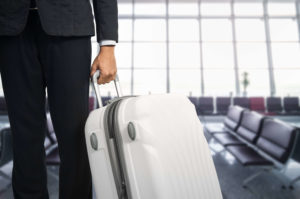 When you’re flying at 35,000 ft. and surrounded by dozens of people in close quarters, that’s exactly when you don’t want bad breath in your life.
When you’re flying at 35,000 ft. and surrounded by dozens of people in close quarters, that’s exactly when you don’t want bad breath in your life.
Unfortunately, traveling is a common time for foul breath to strike. The Academy of General Dentistry calls this specific kind of halitosis “traveler’s breath.” While more than 80 million people suffer from chronic halitosis—and traveling can make this regular condition much worse—anyone can experience traveler’s breath due to long rides or flights.
What makes traveler’s breath especially uncomfortable is the fact that you often come into close contact with others when you have it. On any given trip you could come face-to-face with any number of flight attendants, ticket agents and fellow passengers. And no one wants to see friendly seatmates or helpful attendants put off because of bad breath.
How can you deal with bad breath while traveling? Here at the Center for Breath Treatment, we’ve listed 7 items that you should pack in your carry-on luggage before traveling. We’ll help you make sense of DioxiRinses, toothpaste, and other essentials that preserve your fresh breath and self-confidence no matter what leg of the trip you’re on.
Let’s review why bad breath is more likely when traveling before we get to the remedies.
Why Is Bad Breath Common While Traveling?
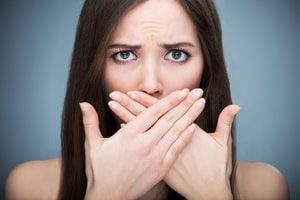 When you’re on an airplane, sudden changes in air pressure cause your body’s functions to slow down, including the production of saliva. Less saliva means more bacteria—and this equals worse breath at higher altitudes.
When you’re on an airplane, sudden changes in air pressure cause your body’s functions to slow down, including the production of saliva. Less saliva means more bacteria—and this equals worse breath at higher altitudes.
Halitosis also develops because of people’s eating habits when traveling. According to J. Nick Russo, former president of the Academy of General Dentistry: “Many people increase their fast food and soda intake while traveling. This leaves food particles in the mouth that produce a sulfur compound and cause bad breath.”
While some people make poor choices for meals when flying, others simply eat less. Hunger and irregular meal times because of time zone shifts are two more causes of in-flight halitosis.
Lastly, many travelers neglect their oral hygiene habits while flying. This works together with the above reasons for bad breath while traveling and makes your breath smell worse the longer you’re in the air.
7 Travel Remedies For Bad Breath
Don’t despair if you think traveler’s breath is a hopeless scenario. Let the Center for Breath Treatment show you the tools to be victorious over halitosis whatever your means of transportation.
1. Travel Size Toothbrush With Toothpaste
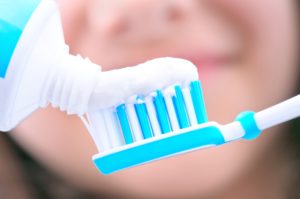 Yes, some airlines do provide pocket-sized toothbrushes and even small toothpaste packets for longer flights. No, you shouldn’t assume that you’ll get these halitosis-fighting essentials—nor should you settle for less than what your mouth deserves.
Yes, some airlines do provide pocket-sized toothbrushes and even small toothpaste packets for longer flights. No, you shouldn’t assume that you’ll get these halitosis-fighting essentials—nor should you settle for less than what your mouth deserves.
Anytime you board a plane, you won’t know:
- If the provided toothbrush will have soft or hard bristles
- The size of the toothbrush’s head
- The amount of bristles on the toothbrush
- If the toothpaste will have fluoride
- How much toothpaste you’ll get
- If you’ll get anything at all
Because of these uncertainties, it’s better to pack your own toothbrush and toothpaste. Choose a soft-bristled brush to clean teeth and remove bacteria in a healthy way. As for toothpaste, pick one with sodium fluoride as this ingredient is known for its bacteria-killing properties.
If you experience chronic halitosis, you might need a more potent toothpaste. We recommend one that contains chlorine dioxide like DioxiBrite, which kills bacteria but also neutralizes the scented sulfur compounds that contribute to bad breath.
Whichever toothpaste you choose, be sure to get a travel-size tube or container to pass airport security guidelines.
2. Floss
No daily oral care time is complete without floss. This means that if you’re serious about fighting bad breath while traveling, floss between your teeth before or after brushing.
Food particles, bacteria and plaque that cause bad breath often lurk in the crevices between teeth and under the gums. Scrubbing away with a toothbrush might remove some of these, but proper flossing is the key to getting rid of these hidden halitosis starters.
When you floss, do so gently and close to the gum on either side of each tooth. Aggressive flossing can actually damage your gums, so be careful!
Lastly, all floss varieties are travel-size by nature which is a plus. Look for shred-free floss for less hassle. As for floss flavors, it’s totally up to you. The way you floss will make a bigger difference in controlling bad breath than the flavor of your floss.
3. Tongue Scraper
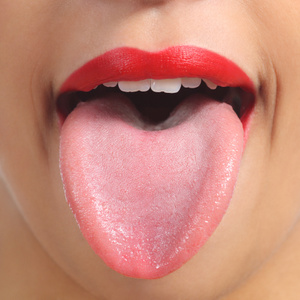 On any given day, your tongue carries the most bacteria within your mouth. This is why cleaning it with a tongue scraper or another instrument is extremely important whether you’re traveling or not.
On any given day, your tongue carries the most bacteria within your mouth. This is why cleaning it with a tongue scraper or another instrument is extremely important whether you’re traveling or not.
A tongue scraper is a plastic or metal tool specifically designed to keep your tongue free of bacteria that causes halitosis. Just place the edge of the scraper on the back of your tongue and gently pull the tool forward.
Of course, if you don’t have a tongue scraper you can also use the regular bristles on your toothbrush. However, studies have shown that toothbrushes can reduce the production of bad breath-causing sulfur compounds by only 45%. A tongue scraper can reduce it by 75%.
As another option, many toothbrushes today feature tongue brushes on the back of the head. These can be more effective at removing bacteria than toothbrush bristles.
Tongue scrapers alone cannot significantly reduce bad breath while traveling. However, they’re easy to pack and use and they’re inexpensive as well. Fighting traveler’s breath to the fullest may require every tool at your disposal, so pack a tongue scraper next time you take a trip!
4. Anti-Bacterial Oral Or Tongue Spray
If you’re serious about combating bad breath on the ground or in the air, use an oral spray. These specifically target halitosis and were created with convenience and effectiveness in mind. Try these two sprays:
BreathRx Anti-Bacterial Tongue Spray – This minty spray contains Zytex—a special combination of zinc, thymol, and eucalyptus oil—together with cetylpyridinium chloride for maximum bacteria-fighting power. As a bonus, it’s all contained within a handy 2 oz. bottle which is well under the TSA’s 3.4 oz. limit for carry-on bag liquids.
CloSYS Oral Spray – While many breath sprays only cover up breath odors, this compact medicated oral spray kills 99% of harmful bacteria in 10 seconds. And like the BreathRX spray, it too is pocket-sized. The CloSYS oral spray weighs in at only .25 fl. oz. per bottle.
Both of these popular products and more are available in our online store, so check them out. They’re easy to use and perfect for beating halitosis on the go in conjunction with consistent oral habits.
5. Pocket Mouthwash
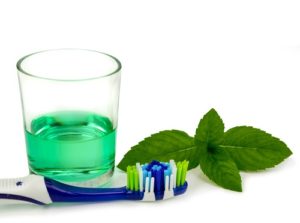 A good mouthwash doesn’t just address bad breath. Many popular rinses also protect against tooth decay, reduce plaque and prevent gum disease. Because of all these benefits, travelers should pack some mouthwash with them for both short and long trips.
A good mouthwash doesn’t just address bad breath. Many popular rinses also protect against tooth decay, reduce plaque and prevent gum disease. Because of all these benefits, travelers should pack some mouthwash with them for both short and long trips.
Antiseptic mouthwashes are some of your best choices to fight halitosis while in transit. This is because they feature a higher quantity of alcohol than other rinses, which makes them more likely to kill bacteria and viruses that cause bad breath.
These mouthwashes often leave behind a burning sensation in the mouth after rinsing and tend to dry out the mouth, which travelers should be aware of. However, some rinses specifically target halitosis without unwanted side effects. Allow us to share our favorite.
DioxiRinse uses active chlorine dioxide to quickly neutralize bacteria and sulfur compounds like no other ingredient available. It even cleanses bacteria-overrun pockets between the teeth and gums too! Best of all, it cleanses gently so that your mouth won’t feel irritated afterward but rather refreshed.
Studies have proven the safety and effectiveness of active chlorine dioxide in mouthwash, so you don’t need to worry. Try DioxiRinse from our online store and place some in a small container. Then you’ll be able to travel in public without fear, anxiety or bad-smelling breath!
6. Sugar-Free Chewing Gum
Sugar-free gum helps fight bad breath with the help of an ingredient called xylitol. This lowers the spread of bacteria and increases saliva production to help minimize halitosis. Of course, chewing gum carries with it another air travel bonus. It relieves you of “airplane ear,” or the discomfort you feel from changing cabin pressure while flying.
Some sugarless gum brands are even ADA-approved, so look out for these gems.
7. Bottles Of Water
 Here’s a disclaimer: don’t pack water bottles within your carry-on bags, as travel security agents will likely consfiscate them. However, be sure to buy a bottle or two once you pass airport security checkpoints.
Here’s a disclaimer: don’t pack water bottles within your carry-on bags, as travel security agents will likely consfiscate them. However, be sure to buy a bottle or two once you pass airport security checkpoints.
Water features many benefits for travelers. Staying hydrated will wash food particles and bacteria away as well as produce more bacteria-fighting saliva. Dehydration on plane trips is common too, which makes this item a must. Continually drinking water during your flight and layovers will ensure that you’ll get maximum effectiveness from the other 6 items on this list.
Struggling With Bad Breath? We’ve Got Answers
Keeping these 7 items close will help you travel with assurance and great-smelling breath. However, if you’re suffering from chronic halitosis there may be deeper issues at work that simple cures might not address.
At the Center for Breath Treatment, we have a success rate of 99% when helping patients overcome bad breath. Both our in-house treatment and home treatment kits have proven effective for people of all ages, backgrounds, and medical situations.
Give us a call today! Dr. Anthony Dailley can give you the health you need to work, travel and live with fresh breath and self-confidence.
SOURCES
Academy of General Dentistry (2012, January). Do You Have Traveler’s Breath?
Academy of General Dentistry (2012, January). Tongue Scrapers Only Slightly Reduce Bad Breath.
Academy of General Dentistry (2012, January). What Is Halitosis?
American Dental Association (n.d.). Halitosis.
D’Souza, J. (2016, March 1). The Causes Of Bad Breath And Why Flossing Is Key.
Shinaka K., et al. (2010, February 12). Effects of a mouthwash with chlorine dioxide on oral malodor and salivary bacteria: a randomized placebo-controlled 7-day trial.
Sturgis, I. (2015, January 29). Constipation, bad breath and ruined tastebuds: What flying REALLY does to your body (and how to fix it).
Wiley, C. (n.d.). Using A Tongue Cleaner For A Cleaner Mouth.
